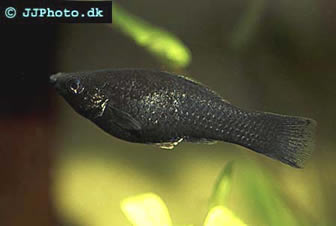Mollies
Mollies are small friendly fish that can be found in most aquarium store and often recommended to beginner aquarists even though there re a lot of fish that is more suitable to beginners than mollies. One reason for me to say that they aren't really good beginner fish is the fact that mollies easily attract disease if they are not given the right conditions. An example of this is the fact that black mollies easily become infested with ich, which has made people recommend keeping the black molly and other mollies in brackish water even though these fishes are chiefly found in freshwater in the wild. (The parasites that cause ich do not tolerate salt.)
All mollies belong to the family Mollienesia, There are 5 different molly species in the wild as well as a large number of different aquarium strains, such as the gold and black molly, the balloon molly and other strains. (Almost) all mollies sold in aquarium stores are hybrids between different mollies and even the mollies that are sold as a specific species is almost always hybrids. If you want pure mollies you will need to turn to wild caught specimens.
Mollies are closely related to guppies and can be kept in much the same way. In the wild, each species is found in a wide variety of different biotopes but the majority of the habitats are slow moving streams with warm hard alkaline water. Ideal water conditions to keep mollies of all species are around pH 7.5 to 8.0, 15-30˚dH and 25-28˚C (77-82˚F). They accept a much wider variety of water conditions and a considerably lower water temperature but they seem to do best in the abovementioned conditions. Wild populations of mollies are only sparsely found in brackish water. There are areas where mollies have been introduced to brackish and even marine water and are thriving.
Mollies are sensitive to stress and should not be kept in aquariums with aggressive or very active fish that stress them. Less suitable fish include many popular barb species that just like the mollies are commonly recommended for beginners. I do not recommend keeping mollies with barbs (cherry barb is an exception), cichlids or large/aggressive fish species. An aquarium in which you keep mollies should be at least 20 gallon (90L) and decorated to reduced stress. This means planted with areas of dense vegetation as well as with open areas where the fish can swim. Males can stress females by pursuing them too aggressively as they try to mate with them and it is therefore important that the females can hide from the males. Dense vegetation also increases the chances of fry surviving in the holding tank. Change about 20% of the water each week and try to keep the water quality as high as possible.
It is often recommended to add salt to the water in aquariums containing mollies and although this isn't necessary it has several benefits. One is that salt reduces the toxicity of nitrate and nitrite; another is that many aquarium diseases and freshwater parasites do not tolerate salt and won't infect your fish if there is salt in the water. If you use marine salt it also contains salts that increase water hardness and pH-value which might make the water more suitable for mollies if you live in an area where the water is a bit too soft/acidic to make mollies thrive. Salt is however not necessary and will offer little to no benefit if you give the mollies the environment they want.
Feeding Mollies
Mollies are primarily herbivores and should not be feed too protein rich food. They do however appreciate some meaty food such as insect larvae and cyclops in their diet. They are best fed 2-3 times a day and an ideal diet might consist of vegetables 2 times a day and something meatier once a day. Mollies accept flake food and a vegetable flake can be the base of the diet you feed your mollies.Breeding Mollies
Mollies are livebearers which mean that they give birth to live young (instead of laying eggs). All mollies are easy to sex and can be sexed by looking at their reproductive organs as well as in many species very visible attributes such as large fins on males. Most species are easy to breed if their demands are met. Pregnant females can easily be stressed and stress often causes miscarriages that kills the fry and can threaten the life of the female. Placing a pregnant molly in a regular breeding trap is a common cause for stress and can have dire consequence. If a breeding trap is used it must be much larger than a normal breeding trap. Another common source of stress in pregnant female mollies is males that try to mate with them. It is therefore important to give the females enough hiding places. If they are kept in a small aquarium it is best to remove the males once a female is fertilized. Poor water quality, other fish etc can also be causes of stress.
If you give your mollies a good stress free environment they will usually spawn and give you fry in due time. The fry is large and can be fed newly hatched brine shrimp as well as crushed flake food. Some fry usually survive in the holding tank unless it is too populated, but for more effective breeding the females need to be moved to birthing tanks from which they are removed as soon as they are finished giving birth. The birthing process can stretch over several days. The numbers of fry per birthing depends on the size of the female but is usually quite low.

